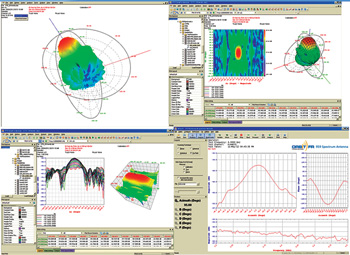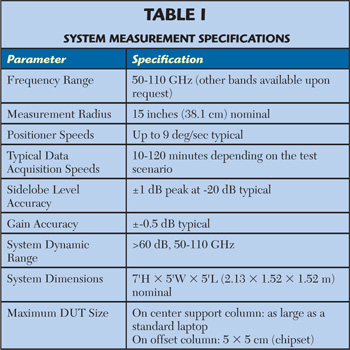
Wireless Gigabit applications that offer advanced high-speed data transmissions are gaining wide interest. The Wireless Gigabit Alliance (WiGig) is currently establishing specifications for the protocols needed to establish an industry uniform standard for data transmissions at rates of up to 7 Gigabits per second (Gbps). This rate is an order of magnitude faster than current communications standards.
The WiGig standard is based on the IEEE 802.11 protocol, and is backward compatible with previous generation capabilities. It can switch between any bands including the 2.4, 5, and the new broadband 60 GHz (7 GHz available bandwidth) spectrum. The switching is transparent and thus provides for seamless operation. The implementation will vary over a wide range of devices such as cell phones, laptop computers and other peripheral devices.

Figure 1 Sample µ-Lab data output.
ORBIT/FR has developed a patent pending portable, low profile product (µ-Lab) that can be used to perform all the required testing on these wireless devices, ranging anywhere from a small on-chip antenna to a cell phone to a laptop computer. It comprises a small anechoic chamber measuring approximately 5 × 5 × 5 feet (152 × 152 × 152 cm). A rack area is underneath the chamber for the workstation computer and positioner controller. An adjacent rack is available for the VNA. The chamber and rack assembly below it will fit through standard double doors.
The chamber houses an azimuth positioner and elevation gantry arm, allowing spherical coverage of the AUT. The AUT is fixed and does not rotate. It is mounted on a column set on the center of the azimuth axis for connectorized antennas. For on-chip antennas, an offset mounted column is used to accommodate the micro-probe assembly. A manual or motorized polarization rotation capability for the near-field probe is supplied. The system can either support spherical near-field measurements using the appropriate near-field to far-field transformations, or directly measure the far-field characteristics for appropriate conditions.
Given the wide range of WiGig applications and devices, a cost-effective, small system such as µ-Lab is required to evaluate these devices rapidly with the ability to change out device types within an hour or two. The µ-Lab system meets these requirements for devices ranging from on-chip antennas to cell phones and small connectorized antennas to adaptive arrays. The antenna development will largely focus on the 60 GHz band, but will also encompass the 2.4 and 5 GHz bands as well. The baseline µ-Lab offering covers the 50 to 110 GHz bands (V- and W-Band), but the other bands can be added, if required. This system provides a unique capability for evaluating the new class of WiGig antennas. A sample of the data from the µ-Lab system is shown in Figure 1, with 2-D and 3-D plotting and analysis capability.

A new millimeter wave test system for the collection of conventional far field and spherical near field EM data of chips and miniature antenna assemblies utilizing WiGig technology. The low profile µ-Lab can be used to perform all the required testing on these wireless devices, ranging anywhere from a small on-chip antenna to a cell phone to a laptop computer. While this system is targeted to support the test needs of the WiGig industry, the system also provides exceptional new capabilities that support antenna testing for existing and emerging technologies across the millimeter wave frequency range. Table 1 shows a summary of the system measurement specifications.
Microwave Vision Group,
ORBIT/FR Inc.,
Horsham, PA
(215) 674-5100,
www.orbitfr.com
